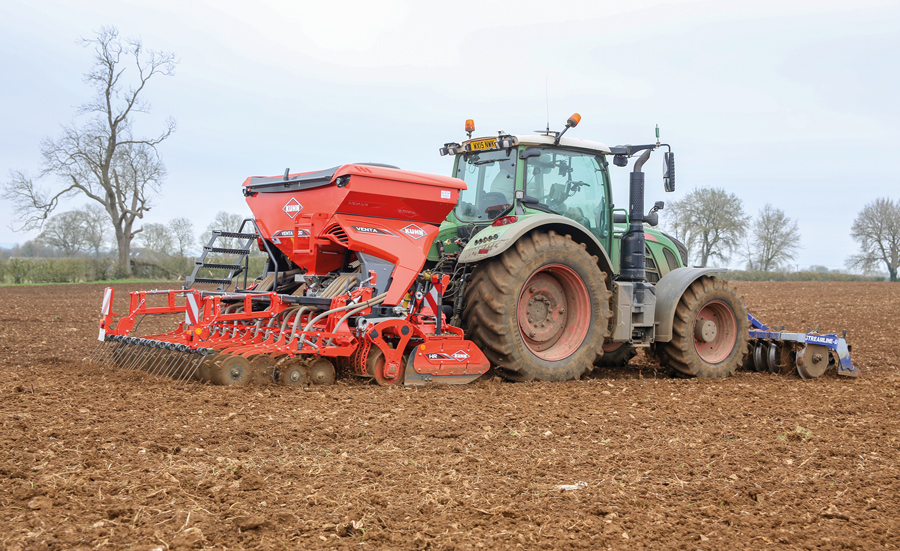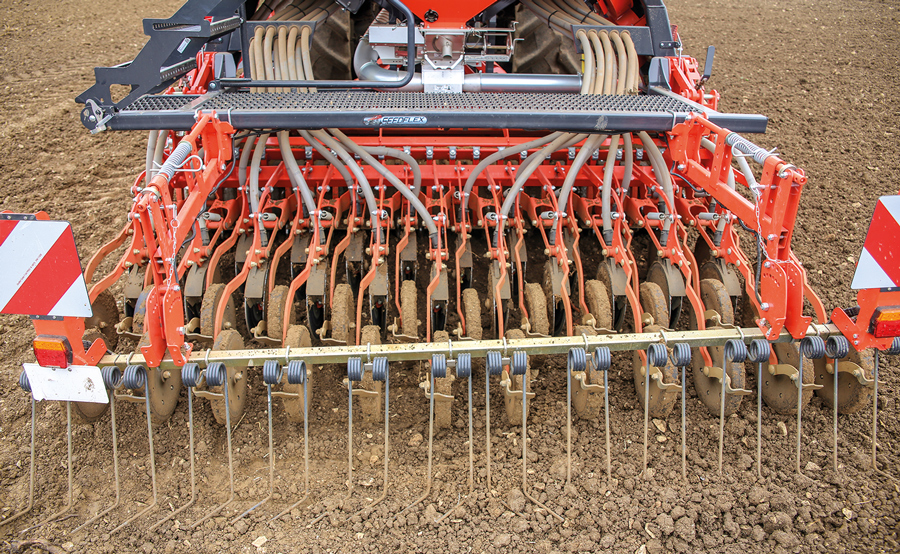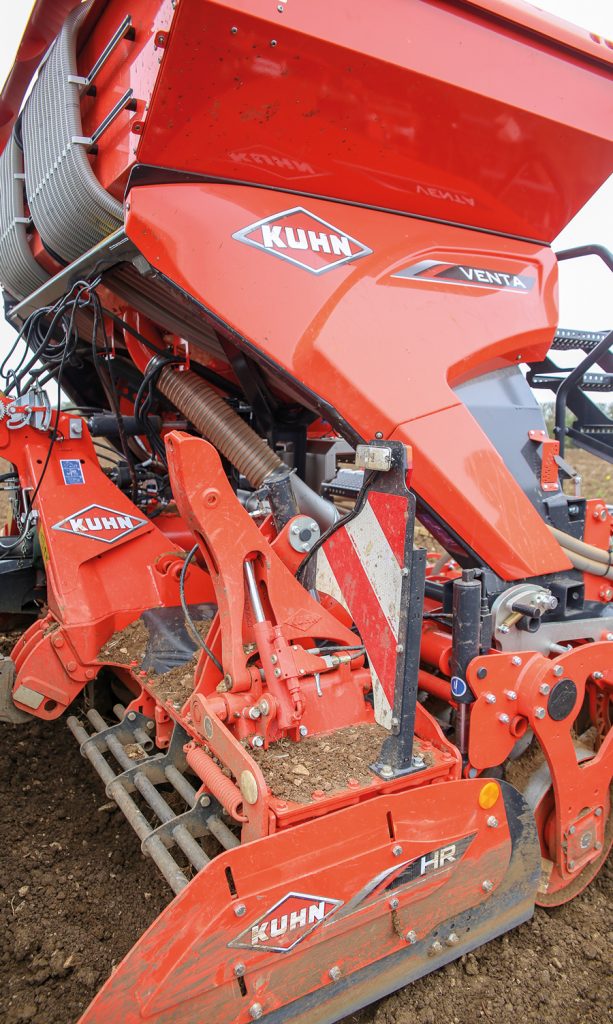Weed control boost with Kuhn drill
3rd May 2019
With reducing numbers of chemical solutions available in the armoury, weed control is a growing challenge…
With reducing numbers of chemical solutions available in the armoury, weed control is a growing challenge. But for one Gloucestershire grower with no chemicals to fall back on, the correct choice of a new drill was essential. David Williams reports.
Trading as Donkeywell LLP, Tim Peachey farms at Quenington, near Cirencester. He is the third generation of his family to farm there having taken over from his father in 2008, and the 280ha of arable cropping is fully organic since his father made the decision to farm without artificial chemicals in 1992. “It wasn’t a lifestyle decision,” Tim explains, “but motivated by higher profits available at a time when conventional produce returns were falling.”
Tricky soils
Soils are mainly Cotswold brash with high stone populations, but more loamy near the farm’s base, and the 6in of free-draining topsoil provides opportunities to work just a few hours after heavy rain, but it means preserving moisture is essential for growing crops. Complementing the organic crop production, the farm is involved in environmental initiatives including 18–19ha of HLS comprising beetle banks, game plots and areas encouraging lapwings and skylarks. A recent bird survey on Tim’s farm identified 58 species of which 15 are ‘red listed’.
The rotation includes two-year clover-based leys on which sheep are grazed adding organic matter and providing an opportunity to keep on top of arable weeds.
“It’s rewarding farming this way as we don’t rush around applying slug pellets, fertilisers or sprays like conventional farms and we enjoy increased wildlife encouraged by availability of insects for food, as well as predators which take advantage of them. We love seeing rooks in the fields as they help control slug numbers, and although we suffer a few bare patches it’s not an issue as we don’t spend on chemicals.”
Spring sown
Arable crops are all spring-established, and the rotation is wheat, barley, oats, then two years of clover. “We used to grow oats after wheat, then barley which is what is generally recommended, but the lack of a decent canopy from the barley allowed vigorous weed growth which affected the following crop. Oats offer improved control and those weeds which take advantage of the barley’s more open growth habit and development are tackled later by the under-sown clover.”
Although the Cotswold brash is often a challenge, getting field work timings right provides natural weed control as the fast drying soil starves disturbed weeds of moisture. “We use a stubble cultivator with following tines to drag weeds to the surface, then the roots dry out and significantly reduce the population. Our main problem weeds are docks and creeping thistle,” Tim added.
Cultivated ground is rolled before winter then left to green before ploughing, while manure is applied to the grass. Straw is sold for organic mushroom production and PAS100 green waste is brought in, supplying much needed P and K. “Our soils tend to be very alkaline so we tackle that by spreading the compost on the grass where it is absorbed and nitrogen is fixed by the clover. Grass is ploughed after the second year in October, then left over-winter ready for spring crops. Rye is being trialled this year as a possible replacement for wheat which has variable results. Clover is established by under-sowing into the oats.
A power harrow/drill combination is favoured for its ability to cope with the stony land and work in a range of conditions. It lets Tim get on earlier than using alternative establishment systems, and he comments that it also saves at least one cultivation pass.
After many years of dependable service Tim updated his machine to another of the same brand, but poor build quality resulted in reliability issues and Tim was soon forced to look at alternatives.
“Farming alone I need machinery I can rely on so other brands were considered, including the latest Kuhn model which I had seen at Lamma. My local dealer Cotswold Farm Machinery provided a demonstration and it performed well. Availability of an extended hopper, increasing capacity to 1,800 litres, was an advantage allowing me to squeeze in two large bags of seed, enabling 5–6ha of drilling between fills rather than 3–4ha.”
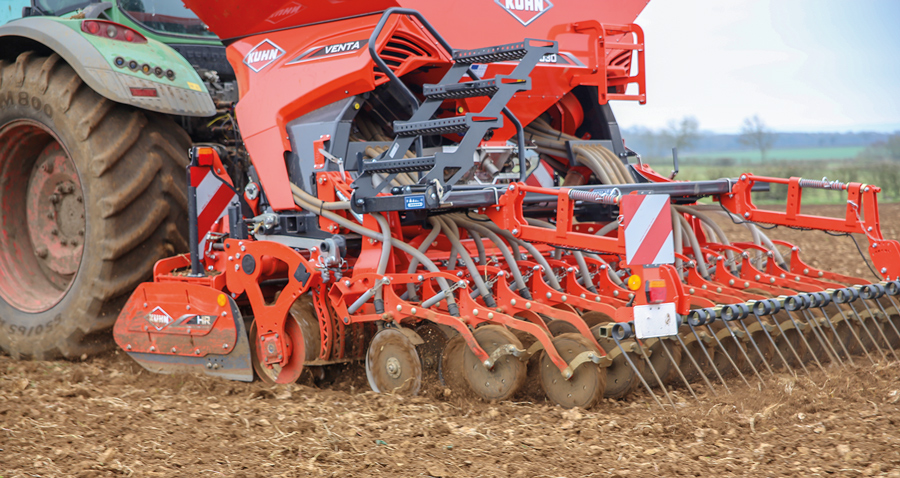
SeedFlex coulters create minimal disturbance outside the seeding area and incorporate rubber rollers which provide depth control and consolidate the seeded area to maximise seed-to-soil contact and retain moisture.
New coulter option ideal
However, the main attraction of the new Kuhn was the SeedFlex coulters – available as an alternative to traditional Suffolk versions. These disturb only a thin strip of soil where the seed has been placed and are followed by narrow rubber rollers which consolidate soil around the seed and act as depth wheels. “I’ve got one field with a significant black-grass problem and hadn’t got around to rolling all of it last year. The rolled area developed a high black-grass population but there was less where the land wasn’t rolled as the soil was drier and grass weeds hadn’t thrived. This made me look at coulter design and I believed that, particularly on our quick-drying soils, leaving the area between seed rows loose would reduce weed establishment,” Tim explained.
The Kuhn Venta HR drill and HR3030 power harrow were supplied last October by the dealer. As well as availability of the SeedFlex coulters, improvements over the previous model include a new chassis with the hopper mounted further forward for easier lifting and improved stability, as well as hydraulic adjustment of the packer roller and levelling bar giving easier adjustment that can be carried out on-the-move.
When Farmers Guide visited in late March, Tim had established approximately 170ha with the new drill. “It’s well made and there have been no problems at all,” he continued.
“The power harrow copes well with our stony ground and the blades are barely worn. It’s performed really well and because conditions were ideal much earlier than usual this year, we drilled our first barley during the first week of January. It’s looking good and establishment across the field is impressively even,” he said.
The only issue to have affected drilling so far this year was that in extremely wet conditions, soil picked up on the rubber depth rollers. “It’s not a problem,” commented Tim. “It’s a good indicator for us as to when conditions are just too wet, as everything has its limit.”
Seed rates
Home-saved seed is preferred, as Tim believes seed produced on his land is from plants which have proved their suitability for his soils. Wheat is drilled at 235–250kg/ha, barley at 185kg/ha and oats are at 165–190kg/ha. “We need to ensure there is enough crop canopy to smother weeds but with plants not so thickly established that their growth is restricted. We opted for 24 coulters at 12.5cm spacing rather than 20 at 15.0cm, because we don’t want too big a gap between seed rows which might allow weeds to thrive.”
Seed is drilled at 25–38mm depth and Tim said that even if the soil type varies across the field, emergence has been even. “Our previous drill was affected far more by soil type and it was easy to see as crops emerged where the coulters had penetrated further or been pushed closer to the surface,” he said.
Typical drilling speed is 10kph, and work rates so far have averaged approximately 3ha/hr, allowing Tim to achieve 20–25ha per day easily on his own.
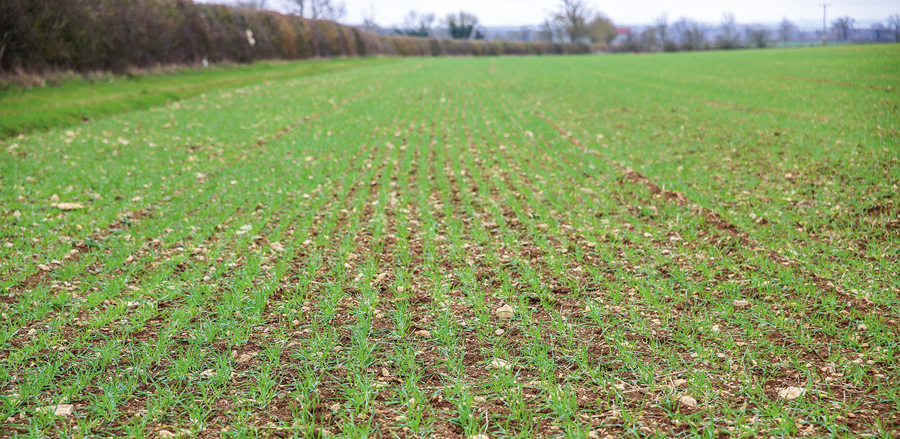
Barley drilled on 5th January was looking good when Farmers Guide visited in late March.
Popular range
Cotswold Farm Machinery area sales manager Guy Medlicott said the Kuhn drill was the first of the latest type sold by the dealer, but that advantages of its design meant it has already created considerable interest. “It’s an ideal main drill for small to medium-sized farms and contractors, but it’s also a ‘get out of jail’ solution for larger farms which often use wider minimum tillage drills when conditions are ideal.
Full Isobus control on the latest model saves customers having to invest in a separate screen and the clever linkage system means drivers can make adjustments quickly and get the most out of the drill very easily. Every drill also comes with a top link-controlled seed flow shut-off, so even those using manual control gain automatic seed flow shut-off when the drill is lifted at the headland.”
The dealer has sold Kuhn machinery for more than 14 years and Guy said the brand’s popularity means examples of almost every product can be seen working within 30 minutes’ drive of the depot. “The line-up is always expanding and additional tillage solutions offering reduced disturbance have been a focus recently, including SeedFlex coulters on zero-tillage drills,” he added.
“I’m really pleased with my decision to buy the Kuhn Venta drill,” concluded Tim. “It out-performs my previous machines’ work rates and accuracy, and creates an ideal environment for seed to flourish while reducing opportunities for weeds to develop. It’s well made, easy to set up and suits my situation ideally, and I know I have a very good local dealer in Cotswold Farm Machinery to provide back-up and advice when needed.”
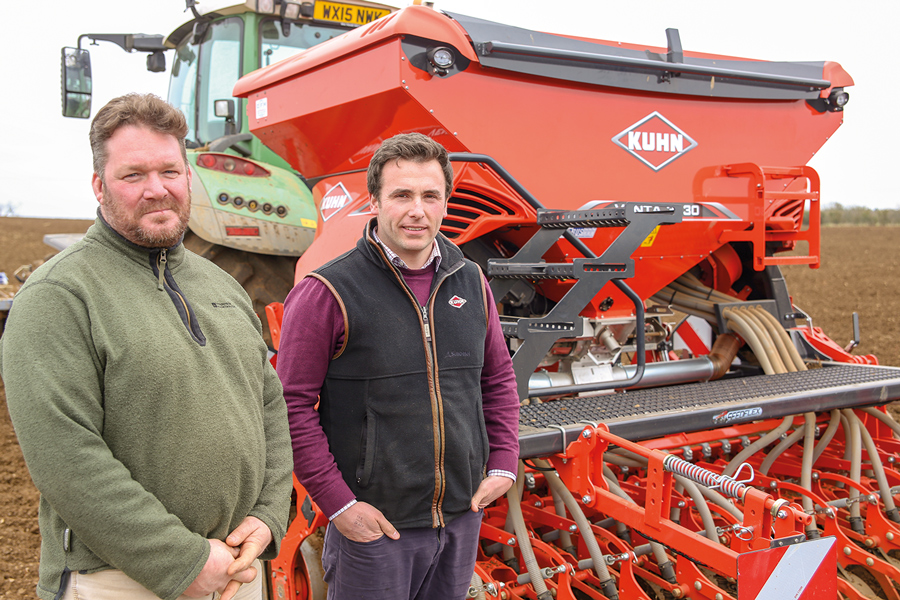
Tim (left) with Cotswold Farm Machinery representative Guy Medlicott.
